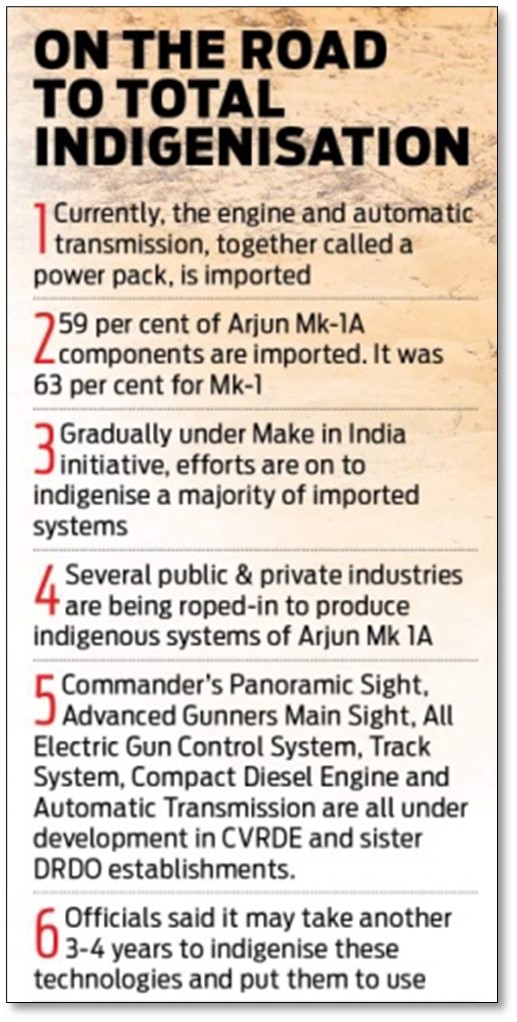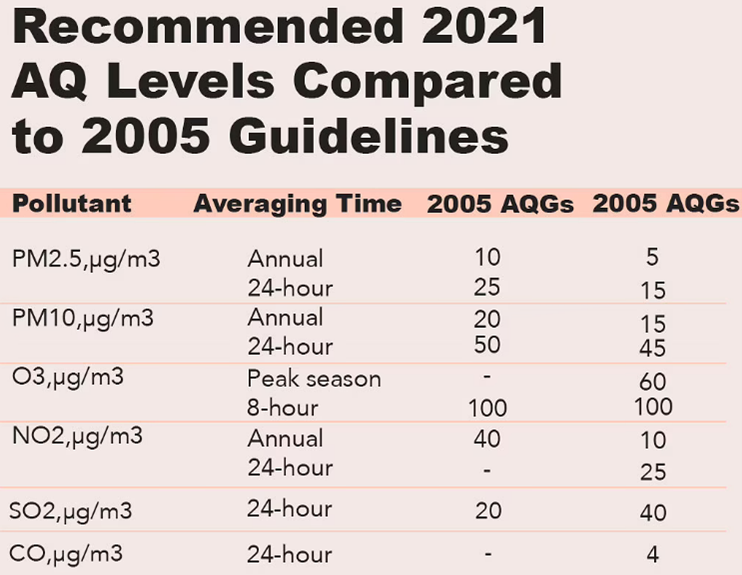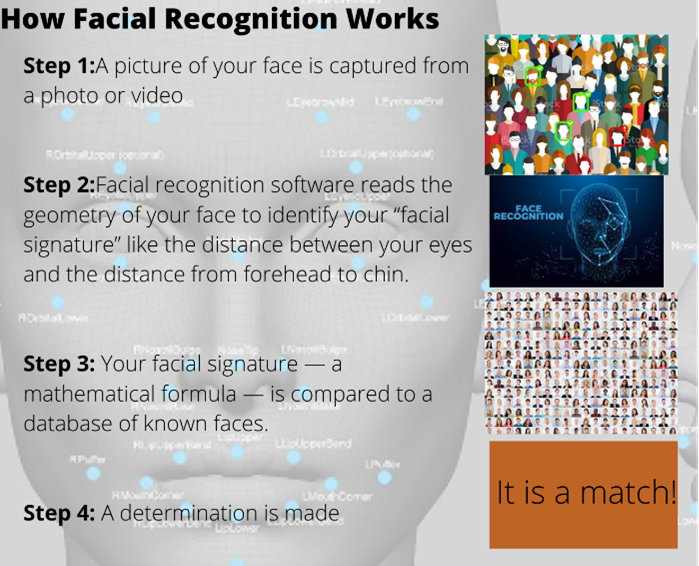Tuesday, 28th September 2021
Vitamin A supplement programme
In News
Recently, researchers of an American Journal argued that the government’s National Vitamin A Supplement (VAS) programme should be discontinued.
About the News
- The survey has recommended to discontinue the VAS, except seven states which are Bihar, Jharkhand, Mizoram, Telangana, Haryana, Madhya Pradesh and Uttar Pradesh.
- Vitamin A is an essential nutrient found in yellow and green vegetables and fruits. It is also found in food items sourced from animals such as milk, butter, eggs and meat products
Concerns regarding the Report and its recommendations
- Cause Deprivation: Such a move would deprive children between six months and five years of the supplement.
- It may adversely impact optimum immune responses against diseases, lead to re-emergence of eye damage and blindness caused by nutritional deficiencies as well as adversely impact the ongoing anaemia control
- Skewed Sample Set: In 20 states, the number of children surveyed was less than 50 per cent of the recommended sample size.
- Vitamin A deficiency is a severe public health problem in not just seven but 12 states.
- The recommendation that all the six UTs, not surveyed under Comprehensive National Nutrition Survey (CNNS), be dropped from VAS based on the status of “neighbouring” states is an unscientific approach.
- Intra state variations are being overlooked.
- Hypervitaminosis: The haste to shift to a “targeted” approach is based on a fear of hypervitaminosis — abnormally high levels of vitamins that can cause toxicity. No cases of hypervitaminosis have been yet reported.
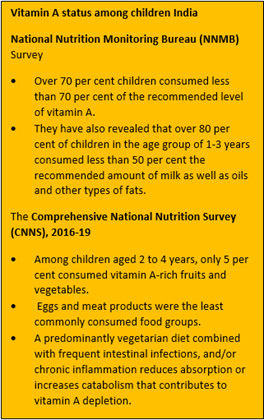
National Vitamin A Supplement (VAS) programme
- The program was introduced in 1970 and modified in 1991, is based on the rationale that the daily diet of children in the country is deficient in Vitamin A.
- It was found that over 70 per cent children consumed less than 70 per cent of the recommended level of this vitamin. (National Nutrition Monitoring Bureau).
- The policy of “Management of Vitamin A Deficiency”, introduced in 1991 was guided by the findings that reported the seroconversion of measles vaccine in field conditions was significantly higher in children who had taken a vitamin A supplement as compared to those who did not.
- With the introduction of the biannual strategy for administering six-monthly vitamin A dose in early 2000, VAS coverage increased from 3 per cent in 2005-6 to 62 per cent in 2015-16 in children in the age group of two to three.
Source:
Quarterly Employment Survey (QES)
In News
Labour and Employment Ministry has released a report of first quarter of Quarterly Employment Survey (QES) part (April to June 2021), of the first round of the All-India Quarterly Establishment-based Employment Survey (AQEES) prepared by the Labour Bureau.
Findings of first round of Quarterly Employment Survey
(Comparisons are with data of sixth Economic Census (6th EC, 2013-14))
- Increase in total employment: 29 percent growth in total employment in nine selected sectors.
- Highest employer: Of the total employment estimated in the selected nine sectors, highest were in Manufacturing (41 percent), Education (22 percent), and Health (8 percent). While employment in trade and accommodation and Restaurants came down.
- Growth: IT/BPO sector witnessed most impressive growth, followed by Health.
- Labour Force: Nearly 90 percent of the establishments have been estimated to work with less than 100 workers, the corresponding figure during EC 6 being 95 percent.
- The over-all participation of female workers stood at 29 percent, slightly lower than 31 percent reported during 6th EC.
- Regular workers constitute 88 percent of the estimated workforce in the nine selected sectors, with only 2 percent being casual workers..
- Skill training: Around 18 percent of the establishments have provision of on-job skill training programmes.
About All-India Quarterly Establishment-based Employment Survey (AQEES)
- AQEES represents nine sectors within each state/ Union Territory, as also each size-class (range of number of workers) within each sector-State/ UT.
- These nine selected sectors are Manufacturing, Construction, Trade, Transport, Education, Health, Accommodation and Restaurant, IT/ BPO and Financial Services.

- Consolidated findings: AQEES will provide a consolidated picture of both the organised and the unorganised segments of the non-farm economy.
- Importance: Such scientifically collected data with purity and integrity that can be cross examined will be beneficial towards achieving targeted and last mile delivery of government programmes and schemes.
Sources:
Digital Health ID card
In News
The government has launched the Ayushman Bharat Digital Mission to provide a digital Health ID to people which will contain their health records.
About the News
- The nationwide rollout of the digital Health ID coincides with National Health Authority (NHA) celebrating the third anniversary of Ayushman Bharat Pradhan Mantri Jan Arogya Yojana (AB PM-JAY).
- Currently, over one lakh unique Health IDs have been created under the National Digital Health Mission (NDHM), which was initially launched across six states and Union territories on a pilot basis on 15th August.
About the Digital health ID
- Unique ID for every citizen: It is unique 14-digit health identification number- for every citizen that will also work as their health account.
- Repository of health records: It will be a repository of all health-related information of a person and will enable access and exchange of health records of citizens with their consent.
- Portable and Accessible: This health account will contain details of every test, every disease, the doctors visited, the medicines taken and the diagnosis which will be very useful as it is portable and easily accessible even if the patient shifts to new place and visits a new doctor.
- Created using Basic Requisites: The Health ID can be created by using a person’s basic details, mobile number or Aadhaar number. Personal health records can be linked and viewed with the help of a mobile application, a Healthcare Professionals Registry (HPR), and Healthcare Facilities Registries (HFR).
- Free of Cost and Voluntary: Health ID under National Digital Health Mission, NDHM is free of cost and voluntary.
Significance of the Digital Health ID Card
- Seamless Online Platform: Based on the foundations laid down in the form of Jan Dhan, Aadhaar and Mobile (JAM) trinity and other digital initiatives of the government, PM-DHM will create a seamless online platform through the provision of a wide-range of data, information and infrastructure services, duly leveraging open, interoperable, standards-based digital systems while ensuring the security, confidentiality and privacy of health-related personal information.
- Greater Interoperability: This mission will create interoperability within the digital health ecosystem, similar to the role played by the UPI in revolutionizing payments
- Helps Better Planning and Implementation: According to the govt, analysis of health data will lead to better planning, budgeting and implementation for states and health programs, which is expected to be big cost optimizer.
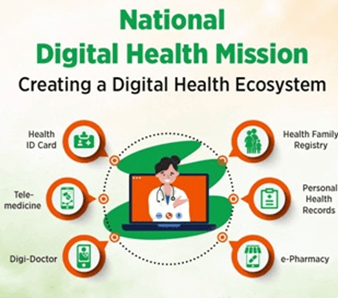
Sources:
Clean Development Mechanism
In News
The Delhi Metro has earned Rs 19.5 crore from sale of 3.55 million carbon credits which it had collected over a period of six years, in its bid towards gaining greater energy efficiency.
About the News
- In 2007, Delhi Metro became the first metro or railway project in the world to be registered by the United Nations under the Clean Development Mechanism (CDM) which enabled Delhi Metro to claim carbon credits for its Regenerative Braking Project.
- For the period 2012-18, combined GHG emission reduction achieved from all the CDM and Gold Standard projects was 3.55 million carbon credits.
What is Clean Development Mechanism?
- About: The CDM is a project-based greenhouse gas (GHG) offset mechanism under the Kyoto Protocol. It allows the public and private sector in high-income nations to purchase carbon credits from GHGs-reducing projects in low or middle-income nations as part of their efforts to meet international emissions targets.
- The Clean Development Mechanism (CDM) is one of three "flexibility mechanisms" (the other two being Emissions trading and Joint Implementation). identified in the Kyoto Protocol to meet their GHG reduction targets. The CDM is the only mechanism that involves developing countries, or non-Annex I countries.
- Certified Emission Reductions (CERs): CDM projects generate emissions credits called CERs, which are then bought and traded. One CER is equal to one ton of CO2(eq) emission reduced. The CDM helps to deliver sustainable development benefits to the host country.
- Management: The CDM projects are managed by the United Nations Framework Convention on Climate Change (UNFCCC).
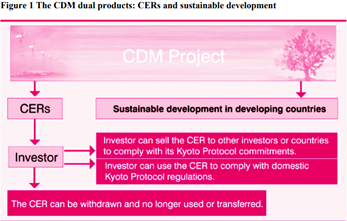
What have been the Benefits of CDM so far?
- Hosting entity: Hosting entities stand to gain from additional investments in their enterprise. Hosting entities benefit from technology transfer, more efficient design, enhanced project feasibility and capital investment.
- Hosting country: CDM projects are a potential source for new foreign investment and augment existing development projects. Other benefits are biodiversity protection, cleaner air and water, and sources of employment and poverty alleviation.
- Investing entity: CDM projects enable private and other entities to comply with domestic GHG reduction regulations and are a mechanism intended to help Annex I countries meet their Kyoto commitments at lower costs.
- Investing country: CDM projects are an option for Annex I countries to receive emission reduction credits at lower costs. CDM projects also offer an established, accountable and secure investment avenue.
- Benefits for the planet: The CDM policy option is not only economically advantageous and politically expedient, but also moves development paths towards ecological sustainability, taking advantage of clean development and more efficient technologies.
India and Clean Development Mechanism: Status of India
- NCDMA: The Central Government constituted the National Clean Development Mechanism Authority (NCDMA) for the purpose of protecting and improving the quality of environment in terms of the Kyoto Protocol.
- Achievements: Along with China and Brazil, India is a leader in CDM since its inception in 2007. India has about 250 million Certified Emission Reduction (CER) units under CDM issued by the UNFCCC. The number of CDM projects registered in India is 1,376 (out of total 7,979 globally) and 89 per cent of these projects are still active.
- Concerns of New Mechanism: The situation may change when market mechanisms mandated under the Paris Agreement come into operation. Most developed countries are strongly opposed to permitting the carryover of CDM projects and credits into the Paris Pact’s mechanisms. The credits lying unsold with the CDM projects could lose their economic worth.
- The CDM gaps among States: The concentration of CDM projects in the more industrialised states and the lacklustre performance of the less industrialised states reflects half-hearted effort from India in capitalising on the CDM´s potential to contribute to sustainable development.
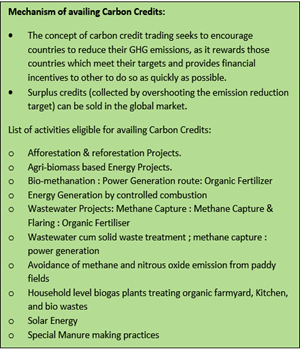
CDM projects are not without their controversies. Concerns Related to CDM
- Sustainable development credentials: Questions surround the sustainable development credentials of certain projects, particularly in the case of industrial gas projects.
- Ethical and Governance Issues: Concerns have also been raised regarding the conduct of project owners, with certain CDM projects implicated in land rights issues and human rights abuses..
- Double-Counting: In the context of climate change mitigation, double counting is widely used to describe situations where a single greenhouse gas emission reduction or removal is used more than once to demonstrate compliance with mitigation targets.
- Double counting becomes prominent where multiple mitigation mechanisms overlap over sources or sinks and when emission reductions are transferred among entities.
- Criterion Problems: Credits for CDM projects are issued after their compliance with internationally approved criteria is ascertained. CDM project proponents should be free to choose available cost-effective technologies as long as the objective of emission reductions is achieved.
- Moreover, “additionality” in CDM projects is judged solely on the criterion of technology; they are also about investments and overcoming market barriers.
Way Forward
- Global environmental integrity: Environmentalists believe that, in case of project/programme-based mechanisms, countries should make arrangements to prevent double counting of emission reduction units in their national accounts.
- Differentiated Principles: The proponents of sustainable development argue that adjustment principle should not be applied uniformly to developed and developing countries. The difference in levels of development of countries needs to be considered.
- Bringing balance: It is time that we rethink the relationship between the project/programme-based emission reduction units and the national pool of emission reductions so as to establish a firm basis for access to future carbon markets.
- Ecology and Economy: To improve the CDM´s contribution to sustainable development in India, the Government of India should consider investing in capacity building in those less developed states. It could reap the double benefit of climate mitigation and economic development.
Conclusion: As global climate action shifts epochs — from the Kyoto Protocol regime, where only developed countries (excluding the US, which opted out) undertook emission reduction commitments, to the Paris Agreement regime, where all countries are bound by their own voluntary commitments, called the Nationally Determined Contributions, or NDCs — the horns of the dilemma are whether or not to allow the offsets accumulated under the Kyoto regime to continue into the Paris regime.
Question: Discuss the Clean Development Mechanism and its benefits. What have been the major concerns w.r.t. this mechanism?
Sources:
- Delhi Metro earns Rs 19.5 crore from sale of 3.55 million carbon credits
- An Implementation Guide to the Clean Development Mechanism
- What is the CDM
- CLEAN DEVELOPMENT MECHANISM
- India's first CDM project
- The CDM Executive Board Considers CDM Beyond 2020
- Kyoto Protocol’s emission trading mechanisms could become redundant after 2020
- Outcome of COP25 balanced, with the exception of Climate Finance issues: Shri Prakash Javadekar
- Fate of Indian carbon credits worth thousands of crores hangs in balance
- The Clean Development Mechanism in India – is it working?
- CLEAN DEVELOPMENT MECHANISM
This Day in History - Rani Rashmoni
On September, 1793, Rani Rashmoni was born. Rani Rashmoni was the founder of Dakshineswar Kali Temple, Kolkata and remained closely associated with Sri Ramakrishna Paramhansa after she appointed him as the priest of the temple. She oversaw the construction of a road from Subarnarekha river to Puri for pilgrims. She funded the construction of ghats such as Babughat, Ahiritola Ghat and Nimtala Ghat for the daily bathers in the Ganges. She donated generously to the then Imperial Library (now the National Library of India) and Hindu College (now Presidency College). Though having such a great spiritual nature the society then had discriminated her. Being born in Chasi-Kaibartta family (Mahishyas) and being a middle-caste Shudra origin, no Brahmin was ready to be the priest in her temple.
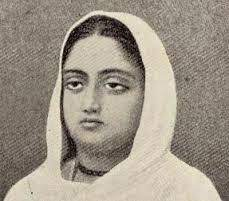
Sources:
Image of the Day - Rare variety flowers
This is image of a rare variety of flowers were found near Vasuki Tal lake near Kedarnath temple in Uttarakhand. The blue-colored lotus-like flowers have become a major attraction for tourists. These flowers have been seen here after a long time as the species of Neelkamal and Soliya are rare.

Source:
Contactless Credit Card
- Context: The Federal Bank has launched 'Federal Bank RuPay Signet Contactless Credit Card' in association with NPCI.
- Contactless credit cards are those that have a small embedded chip that emits short-range radio waves.
- The card when placed within a few inches of a contactless-enabled payment terminal, the payment information gets transferred.
- The RuPay Signet card comes with the lowest Annual Percentage Rate ((APR)-yearly rate charged for a loan or earned by an investment), starting at 5.88% per annum.
- This card has significant potential to attract new-age customers as the cardholders will gain access to a wide variety of offers and deals across categories including travel, food and dining, shopping, sports, entertainment, lifestyle etc.
- The card is presently offered to existing customers of the bank and is immediately made available for use in FedMobile-Federal Bank's mobile banking application, through a 3-click process.

Sources:
Glow in the dark Bionic plants
- Context: Scientists at MIT has created a glow in the dark bionic plants that can be charged with LEDs.
- The light-emitting plant was created using nanoparticles embedded in plant leaves that can glow brightly for several minutes after being charged just for a few seconds with an LED.
- This was done to develop plant-based lighting by using the renewable chemical energy of living plants.
- The plants use nanoparticles containing the enzyme Luciferase that is also found in fireflies to produce light.
- The particles can be infused into the plants through the stomata, the small pores located on the surfaces of leaves.
- The particles then accumulate in a spongy layer called the mesophyll, where they form a thin film that can absorb photons or light particles either from sunlight or an LED which later they emit as light.

Sources:
Ahoms- Protected Class Status
- Context: Assam’s Chief Minister has stated that Ahoms will be accorded “protected class status” in tribal blocks and belts of Assam.
- The Ahom or Tai-Ahomis an ethnic group from the states of Assam and Arunachal
- The members of this group are the descendants of the Tai peoplewho reached the Brahmaputra valley of Assam in 1228 and the local indigenous people who joined them over a period of time.
- They originated in the Chinese province of Yunnan and began migrating into Indochina and northern Myanmar (Burma) in the first centuries AD.
- The Ahoms ruled much of Assam from the 13th century under Chaolung Sukapha who was the founder of the Ahom Kingdom.
- The province was then annexed to British India in 1826 with the signing of the Treaty of Yandaboo.
- Their power in Assam reached its peak during the reign of King Rudra Singh (1696–1714).

Sources:
- Ahoms will be accorded protected class status in tribal blocks and belts of Assam: Assam CM Himanta Biswa Sarma
- Ahom
- Ahom to get protected class status in tribal zones: Assam CM Himanta Biswa Sarma
Image Source:
Samudra Shakti
• Context: The 3rd Edition of exercise 'Samudra Shakti' in the Sunda Strait was recently held.
• Samudra Shakti is a bilateral maritime exercise between India and Indonesia that aims to enhance mutual understanding and interoperability in maritime operations between the two navies.
• It was conceived in 2018 as a bilateral IN-IDN exercise in pursuance of India’s Act East Policy.
• The exercise has matured in complexity over the last two editions and involves the conduct of complex maritime operations including Military Interdiction Operations (MIO), Cross Deck Landings, Air Defence serials, Practice Weapon Firings, Replenishment Approaches and Tactical Manoeuvres.
• INS Shivalik and Kadmatt, indigenously designed and built multi-role Guided Missile Stealth Frigate and Anti-Submarine Corvette, represented the Indian Navy.
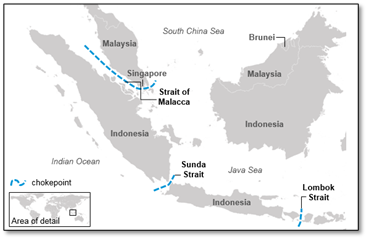
Sources:
- Indian & Indonesian Navy Participate In 3rd Edition of 'Samudra Shakti' In Jakarta
- INDIAN NAVY AND INDONESIAN NAVY PARTICIPATE IN EXERCISE ‘SAMUDRA SHAKTI’
Image Source:
Cryptocurrency — the time to act is now- HBL
Essence: There is a growing demand for cryptocurrency as an investment asset and it has the potential to reshape global finance and banking sectors. This is because it is based on blockchain technology, a decentralized platform which ensures transactions with transparency and strong privacy. But the challenges to cryptocurrency are high volatility, rise in number of cryptocurrencies, misuse through money laundering, lack of ensuring inheritance and possible asset bubble bust. India needs to acknowledge the challenges and design a solution oriented regulatory framework to cash in the potential of cryptocurrencies.
Why you should read this article?
- To know about the changing nature and the potential of cryptocurrency.
- To understand the challenges to cryptocurrency.
- To get an idea about the status of regulation of cryptocurrency in India and what kind of regulatory measures are needed.
Source:
The growing strategic importance of outer space- IE
Essence: India opened new pathways for outer space cooperation with the Quad members based on recognition of the centrality of emerging technologies in shaping the 21st-century global order and the urgency of writing new rules for the road to peace and stability in outer space. Going beyond the traditional arena of open sea routes, the setting up of a new quad working group to discuss space-related issues would be a new and much needed venture for space cooperation.
Increasing private players, military activity, research into space situational awareness and weather activities and expansion of Chinese capabilities in space have reshaped astropolitics. Hence, there is a need for reinforcement and renewal of the agreements like the Outer Space Treaty and the Moon Treaty (1979). India needs substantive national policy action mandated by the highest political order in outer space.
Why you should read this article?
- To understand the strategic importance of outer space.
- To understand the evolving dynamics of technology and creating a global order.
Source:
India’s Parliament must overcome its dysfunctional ways- HT
Essence: The article revolves around the issue parliamentary efficiency and government accountability in the parliament. Recent campaign “Mission 5000” to “discipline” the 5,000 elected representatives across Parliament and state legislatures has triggered a debated over “name and shame” of the Parliament members. Though public holding elected representatives accountable is the very essence of democracy but to omit government’s accountability in the functioning of Parliament is a major concern. It is important to ensure issues raised by MPs are given adequate time (zero hour/question hour) by correctly observing the rules of procedure. A number of bills of immense significance either referred to committees for scrutiny or not but are passed in mechanical speed. Hence, corrective measures are needed to improve Parliament’s functioning.
Why should you read this article?
- To get an overview of issue factors involved in frequent disruption of Indian Parliament.
- To understand the possible steps that could be taken to tackle the issue.
Source:
Tribal Community saving the Malkangiri
Background of Malkangiri
- It is the land of Bonda tribe, one of the 13 PVTG, and is among the 100 most underdeveloped and poverty-stricken districts of India.
- Climate change: has deeply affected their subsistence living.
- Soil fertility: has declined due to heavy rains and use of chemical fertilizers.
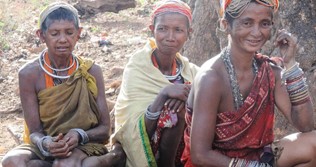
Saving the fragile ecosystem
- Women at the core: Bonda women are addressing the issue of climate change by reverting to the cultivation of native millet varieties.
- Soil conservation: Surface soil conservation has improved, and there is less erosion and siltation on the Bonda hill
- Back to the basics: Using biological pest control methods has effectively reduced expenditure on pesticides.
- Migration: Young Bondas migrating to citieshave brought back modern sustainable techniques for farm practices.
Quote:
Leadership is not a person or a position. It is a complex moral relationship between people based on trust, obligation, commitment, emotion, and a shared vision of the good.- Joanne Ciulla
Source:
Share the article
Get Latest Updates on Offers, Event dates, and free Mentorship sessions.

Get in touch with our Expert Academic Counsellors 👋
FAQs
UPSC Daily Current Affairs focuses on learning current events on a daily basis. An aspirant needs to study regular and updated information about current events, news, and relevant topics that are important for UPSC aspirants. It covers national and international affairs, government policies, socio-economic issues, science and technology advancements, and more.
UPSC Daily Current Affairs provides aspirants with a concise and comprehensive overview of the latest happenings and developments across various fields. It helps aspirants stay updated with current affairs and provides them with valuable insights and analysis, which are essential for answering questions in the UPSC examinations. It enhances their knowledge, analytical skills, and ability to connect current affairs with the UPSC syllabus.
UPSC Daily Current Affairs covers a wide range of topics, including politics, economics, science and technology, environment, social issues, governance, international relations, and more. It offers news summaries, in-depth analyses, editorials, opinion pieces, and relevant study materials. It also provides practice questions and quizzes to help aspirants test their understanding of current affairs.
Edukemy's UPSC Daily Current Affairs can be accessed through:
- UPSC Daily Current Affairs can be accessed through Current Affairs tab at the top of the Main Page of Edukemy.
- Edukemy Mobile app: The Daily Current Affairs can also be access through Edukemy Mobile App.
- Social media: Follow Edukemy’s official social media accounts or pages that provide UPSC Daily Current Affairs updates, including Facebook, Twitter, or Telegram channels.


